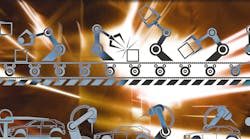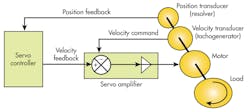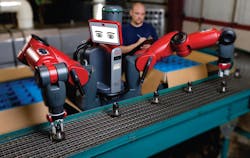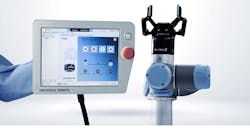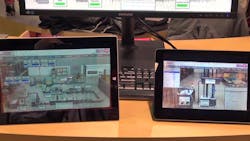What’s the Difference Between Motion-Control and Robotics Systems?
Download this article in PDF format.
Automating the factory floor is a growing trend across the industrial space. It’s not hard to understand why, since such applications help improve efficiency and production rates. To create the automated factory, an engineer can implement a motion-control system or introduce a robotic system. Either can be used to accomplish the same task. However, each has a unique setup, programming options, motion flexibility, and economic benefit.
The Basics of Motion Systems and Robots
A motion-control system is a straightforward concept: Initiate and control the movement of a load to perform work. They are capable of precise speed, position, and torque control. An application requiring the positioning of a product, synchronization of separate elements, or the rapid start and stop of motion are case examples for the use of motion control.
Such systems are typically comprised of three basic components: the controller, the drive (or the amplifier), and the motor. The controller plans the path or trajectory calculations, sending low-voltage command signals to the drive and applying necessary voltage and current to the motor, resulting in the desired motion.
Programmable logic controllers (PLCs) provide an inexpensive and noise-free method of motion control. Ladder-logic programming has been a staple for PLCs, with newer models featuring human-machine-interface (HMI) panels that are visual representations of the programming code. PLCs can be used to control multiple motion-control setups and logic control on machinery.
In a typical PLC-based motion-control system, the high-speed pulse output cards are used in PLCs to generate a pulse train for each servo or stepper drive. The drive receives the pulses, and for each pulse indexes the motor shaft a pre-set amount. A separate signal is used to determine the direction of travel. This method is known as “step and direction.”
The diagram illustrates a typical motion-control system, including a servo controller, motors, and transducer.
Common terminology within the motion-control lexicon includes:
- Velocity: The rate of change of position with respect to time; a vector quantity composed of a magnitude and direction.
- Speed: The magnitude of velocity.
- Acceleration/deceleration: The rate of change in velocity with respect to time.
- Load: The driven elements of the servo system. This includes all of the machine’s components and the work being moved.
- Servo amplifier: Device regulates power to the servo motor.
- Servo controller: Also known as the position controller, the device supplies the programming or instructions to the servo amplifier, usually in the form of analog dc voltage signals.
- Servo motor: Device that moves the load. This is the primary moving element, and it may include a range of prime movers like actuators and induction motors.
- Stepper controller: Device that supplies pulses to excite the windings of a stepper motor and induce mechanical rotation. It is also known as a velocity controller. The frequency or pulses determine the motor velocity and the number of pulses determines the motor position.
- Resolver: A device that monitors the position of the servo motor and the load. Also known as the position transducer.
- Velocity transducer: Also known as the tachogenerator, it monitors the speed of the servo monitor.
Baxter from Rethink Robotics is a perfect example of the ready-to-go collaborative robot solutions available today.
According to the Robot Institute of America, “a robot is a reprogrammable, multifunctional manipulator designed to move material, parts, tools, or specialized devices through variable programmed motions for the performance of a variety of tasks.” While several of the components found in a motion-control system are found inside robots, they are fixed within the robot. The motor speed, actuator, and mechanical links are part of the robot’s makeup.
The components that make up a robotic system are similar to those of a motion-control system. There is the controller, which allows parts of the robot to operate together and connects it to other systems. The program code is entered into the controller. Also, many modern robots use HMIs built on computer operating systems such as a Windows PC.
The robot itself could be an articulated robotic arm, Cartesian, cylindrical, spherical, SCARA, or a parallel picker robot. These are considered the most typical industrial robots. For a full list of robots, reference our “What's the Difference Between Industrial Robots” guide.
Robot systems also have drives (i.e., engines or motors) that move links into their designated positions. The links are the sections between the joints. Robots use hydraulic, electric, or pneumatic drives to achieve movement. Sensors are utilized for feedback from the robot’s environments, providing sight and sound used for operation control and safety. They collect information and send it to the robot controller.
Sensors enable collaborative robots—the electrical resistance or touch feedback allows robots to operate around human workers. End effectors connect to the robot’s arms and function as the hand; they come into direct contact with the product being manipulated. Examples of end effectors include grippers, suction cups, magnets, and welding torches.
The Differences Between Motion Systems and Robots
One major difference between these two systems is time and money. Modern robots are advertised as ready-to-go turnkey solutions. A robotic arm, for example, is already constructed and simple to setup.
Universal Robots offers common examples of setup-and-go robots. They can be programmed via the HMI controller panel, but also by recording position movements with the software interpolating the travel motion. The end effectors can be swapped out for your needs and the engineer need not worry about individual programming of the robot motion parts.
Universal Robots offers simple record position programming to help the end user. The end effectors can swap out for specific applications.
The downside of a robot is the cost. On the other hand, the components that make up a motion-control application are modular, and being able to have modular control of a motion system provides greater cost control. However, there is a greater knowledge demand on the user to properly operate the motion-control system. Its components will need individual programming from the end user.
If the engineer requires multiple setups, modular configuration availability, and cost constraints, a motion-control system provides the benefits sought by an engineer. An engineer with experience can dedicate the time needed to program, setup, and troubleshoot a motion-control system. One can mix and match old and new hardware as well as create workaround solutions for the systems.
Rockwell Automation’s FactoryTalk is a modern software controller that functions in both motion-control and robotic systems.
The next major difference between the two systems is software. In the past, hardware drove the purchasing decisions, but now product hardware differences vary slightly. Motion-control systems that rely heavily on hardware, especially legacy systems, would require more maintenance to ensure correct operation. Closed systems or modern plug-and-play components rely more on software for their operations.
Functionality of the software is crucial, as many users expect modern controllers to perform all of their required tasks out of the box. This means that less money will be spent on individual components, and more of it will go to monitoring operations such as PCs and advanced HMIs.
Users also expect software controllers to be easy to use. The easier it is to interface and operate a controller, the more likely users will choose it for their application. This saves time and money on training and setup. Modern controllers that can be used on both motion systems and robots have software options that provide several automated processes.
